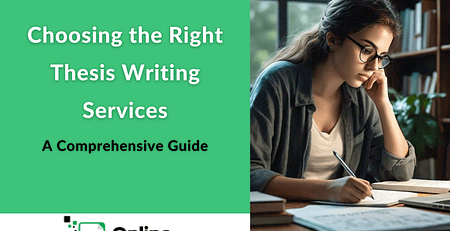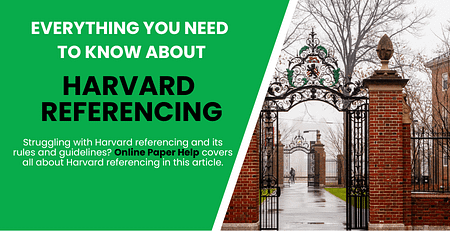Everything You Need to Know about Oxford Referencing
Everything You Need to Know about Oxford Referencing
Oxford referencing, or the documentary note system is a well-established method of citing sources in academic writing. One of the key advantages is its clarity and precision. It employs the system of footnotes and endnotes. With these notes, writers can provide detailed information about their consulted sources without losing the main text. From this, you can easily enhance the document’s readability and provide readers access to the details of the sources. Understanding this citation style will not only strengthen your writing but also contribute to your academic’s overall quality and integrity. Correctly citing sources in your work demonstrates your respect for intellectual property and acknowledges the contributions of others.
In this comprehensive guide, the experts from Online Paper Help take you through the key aspects of Oxford referencing. By the end of this article, you’ll have a clear understanding of how to use this citation style effectively.
What is Oxford Referencing?
Oxford referencing is also known as the Oxford citation style. It is a widely used system for citing sources in academic writing. It is primarily used in humanities, history, literature, and philosophy. This style uses a system of footnotes or endnotes and a bibliography to provide detailed information. This distinguishes it from other citation styles, such as APA and MLA. It provides a structured format for citing sources, which helps you give proper credit to the original authors and avoid plagiarism. There are specific guidelines for referencing different sources, such as books, journal articles, and websites, in Oxford style. Oxford referencing system ensures that sources are properly acknowledged and credited, maintaining academic integrity and transparency in research and writing.
1. Advantages of Oxford Referencing
Clarity
The Oxford style ensures that readers can easily trace the source of information. Providing footnotes and endnotes that contain citation details means giving more details about the sources you used. So, if someone reading your work wants to know more about a specific source, they can easily find it in these notes. It’s like making a map of the sources you used. This makes your work easier to understand because people can see where your information comes from.
Academic Integrity
Academic integrity is significant when you are doing academic work, such as research papers and essays. Oxford referencing system helps you maintain academic integrity. It is like a set of rules for giving credit to the people who wrote the books and articles you use in your work. It is a way of showing respect for the original authors and researchers.
Precision
It is the most important part of referencing. This means being careful and accurate while giving credit to the sources. The Oxford system is detailed and exact, as it gives a lot of information about the sources you use. From these, readers can tell who wrote the sources, when it was published, and even which page they got the information from. Precision helps ensure that your references are correct and others can easily check the sources.
Historical Context
Oxford referencing is one of the most helpful tools, especially when you are studying things that happened a long time ago or need to mention many sources. This referencing system is great when you are writing about stuff that happened in the past. It also helps you add historical details to your writing, like old stories or events.
Uniformity
This approach plays a vital role in enhancing the overall appearance of academic writing. By following the strict guidelines, writers can ensure that their citations consistently follow the same format. With attention to detail, Oxford referencing ensures that the document maintains a cohesive and coherent appearance, ultimately contributing to a polished and professional end product.
Reader-Friendly
You know how sometimes when you’re reading something, and there are numbers or information all over the main text? That can be confusing. Oxford referencing helps you avoid that. Instead of cluttering your main text with lots of citation information, this system puts that stuff in special notes called footnotes or endnotes. Readers can focus on your words without getting distracted by many numbers or notes in the middle of your writing. This makes your work easy on the eyes and enhances the overall readability of your essay writing.
Easy Revision
When you write something and need to fix or add information about your sources, like books or articles, it is easy to do with Oxford referencing. You don’t need to rewrite your whole paper. Instead, you can make changes in the footnotes or endnotes without messing up your main text. This flexibility comes in handy when you’re reviewing or editing your work. So, to put it simply, Oxford referencing is like having a magic pen that lets you make changes to your paper without causing a big mess.
Cross-Referencing
This style of referencing facilitates seamless navigation between various sections within your work. It eliminates the need for readers to engage in tedious searches for additional information or related sources. It is user-friendly and connects the primary text to relevant footnotes and endnotes. Moreover, the cross-referencing feature of Oxford referencing makes it an effective tool for academic and research paper writing.
Comprehensive Attribution
The referencing style goes beyond the simple source citation, which extensively acknowledges both primary and secondary sources. With comprehensive attribution, researchers can gain a deep understanding of the correctness and uniqueness of the ideas within their field. Comprehensive attribution serves as a powerful asset. It allows writers to credit the original sources that influenced their work. This style promotes a deeper level of engagement with research material, which allows researchers to uncover hidden insights and perspectives.
Building Research Skills
Developing strong research skills through Oxford referencing is an important academic and professional growth aspect. This approach teaches individuals how to cite their sources effectively and the importance of in-depth research. Mastering the Oxford referencing builds valuable research to identify and properly cite sources. These skills can be applied to various academic and professional pursuits.
2. Rules of Oxford Referencing
Footnote Placement
In academic writing, the placement of footnotes is essential for clarity and consistency. It is typically placed at the bottom of the page or at the end of the document. Also, the choice of placement depends on the style guide or the specific requirements.
Numbering Footnotes
When numbering footnotes, it is essential to use a consistent format. Standard methods include using sequential numbers throughout the document.
Consistent Format
Maintaining a consistent format is crucial for overall readability and professionalism. This includes consistency in using the same fonts, margins, line spacing, and other formatting elements. It also extends the presentation of citations, references, and footnotes throughout the work.
Abbreviations
It plays an important role in enhancing the readability of your writing. When using abbreviations, ensure that you provide the full form of the terms when they are first mentioned and the abbreviation followed in parenthesis. Afterwards, you can use the abbreviation without repeating the full term.
Punctuation
Proper punctuation is essential in citations. Pay attention to the correct placement of commas, periods, and other punctuation marks within your citations. These errors can disrupt the flow of your text and convey a lack of attention to detail.
Author’s Names
When citing the author’s names, it’s important to follow the citation style’s guidelines. Different styles may require different formats for author names, such as using first-name initials or full names. Consistency in formatting author names is essential for academic writing.
Page Numbers
Citing page numbers is essential when quoting or paraphrasing text from a source. Make sure to include accurate page numbers to provide readers with a precise reference point within the source. Consistency in this practice is vital for clarity and accuracy.
Editions and Translations
When citing editions or translated works, specify the edition or the translator’s name, as required by your citation style. Maintaining consistency in this information ensures that your readers can access the exact source you used.
Multiple Authors
Citing sources with multiple authors involves listing all authors’ names in accordance with the citation style guide. Using “et al.” for additional authors beyond a specified number is a common practice to maintain conciseness.
Citing Images and Tables
When including images, tables, or figures, label them appropriately and provide citations below or alongside them, consistently following the Oxford citation style. Use captions or footnotes to acknowledge the source of the image or table, adhering to the citation style guide’s requirements. This practice enhances the readability of your document and allows readers to find the sources of visual content.
3. Examples of Oxford Referencing
Oxford Referencing a Book
In the case of a book, the Oxford referencing style would involve citing the author’s name, book title, edition (if applicable), publisher, publication year, and the page number where the information is found.
Format for footnotes and reference list
- 1 Author, Title of Book in Italics: Subtitle in Italics, edition number, Place of Publication, Publisher, year, page number.
- In your Reference List, the author’s initials come after the surname.
Example for footnotes:
1 P. Clause, The Art of Writing, 2nd edn., Oxford University Press, Jane Doe, 2020, p. 56.
Example for the reference list
Clause, P., The Art of Writing, 2nd edn., Oxford University Press, Jane Doe, 2020
Oxford Referencing a Journal
You would include the author’s name, article title, journal name, volume and issue number, publication year, and page numbers for a journal article.
Format for footnotes and reference list
- 1 Author, ‘Title of Article: Subtitle’, Title of Journal in Italics, vol. xx, no. xx, year, p. xx.
- In your Reference List, the author’s initials come after the surname, and the full range of the article’s pages is added.
Example for footnotes
1 P. Emily, ‘Exploring Oxford Referencing’, Academic Journal, vol. 2, no.5, 2019, p. 45.
Example for reference lists
Emily, P., ‘Exploring Oxford Referencing’, Academic Journal, vol. 2, no.5, 2019, pp. 45-60
Oxford Referencing a Website
When citing a website, you must provide the author or organization, webpage title, URL, and the date you accessed the information.
Format for footnotes and reference list
1 A. Author, ‘Title of Document’, Name of Website in Italics, Place of Publication, Name of Publisher, year, page number, http://url, (accessed day month year).
Footnote example
1 A. Sarah, ‘The Evolution of Robotics’, Robotics Today, London, Robotics Publishing, 2023, p. 15, http://www.roboticstoday.com/evolution, (accessed 6 November 2023).
Reference list example
Sarah, A., ‘The Evolution of Robotics’, Robotics Today, London, Robotics Publishing, 2023, p. 15, http://www.roboticstoday.com/evolution, (accessed 6 November 2023).
4. Common Mistakes of Oxford Referencing
Plagiarizing Sources
Failing to attribute ideas and content to their original sources properly, whether in academic papers or general essay writing, can result in severe consequences, including academic penalties. Understanding and following ethical guidelines for Oxford referencing is crucial to avoid plagiarism. Always properly attribute ideas and content to their original sources to maintain academic and ethical integrity.
Forgetting to Update URLs
If you don’t update or check URLs in your citation, then they become broken links over time. It makes your citations useless and makes it difficult for readers to access online sources. It can also impact the reliability of your work.
Overusing Footnotes
Overusing footnotes can overwhelm readers with excessive additional information. It is essential to keep the balance, use the footnotes when necessary, and keep them concise.
Improper Abbreviations
Improper use of abbreviations can lead to misunderstanding and confusion. Using unfamiliar or unconventional abbreviations may distract readers from your main message.
Incomplete Source Information
Failure to provide a complete source of information can make it challenging for readers to locate the sources you have referenced. It can damage the credibility of your work.
Missing Footnotes
You fail to properly attribute your sources by omitting footnotes in your writing. With this, your work can lead to accusations of plagiarism and can damage your academic and professional reputation. It’s important to correctly include all footnotes to give credit to the original authors and avoid any ethical and legal issues.
Incorrect Punctuations
This can affect the clarity and readability of your writing. It may lead to misunderstandings and misinterpretations, which makes it difficult for readers to follow your arguments. It can also affect the overall professionalism of your work.
Citing Unreliable Sources
Referencing unreliable sources can damage the credibility of your work. Using reputable and trustworthy sources to support your arguments and claims is essential.
Neglecting Page Numbers
Not including page numbers can affect the ability of your readers to verify the specific information you are referencing within a source. This can lead to a loss of credibility and can be troublesome in academic and research writing.
Mixing Citation Styles
Inconsistent citation styles within a document can confuse and make your work appear unprofessional. Maintaining a consistent and appropriate citation style throughout your writing is essential to provide clarity and reliability.
FAQs
1. Is Oxford Referencing reliable?
Oxford referencing is the most reliable and credible citation style in academic writing. It offers a structured and organized way to cite sources, ensuring the credibility of your references.
2. Is there any difference between Harvard and Oxford referencing?
There are many differences between Harvard and Oxford referencing. In Harvard citation, you typically use author-date citations within the text and provide a reference list at the end. In Oxford Referencing, you use footnotes or endnotes to cite sources. Your references are usually listed in a separate bibliography.
3. When was Oxford referencing published?
It doesn’t have a specific publication date since it’s a referencing style developed and maintained by the University of Oxford. It has evolved, and you should use the latest version or follow your institution’s specific guidelines.
4. How do I cite multiple authors in Oxford Referencing?
To cite multiple authors in Oxford Referencing, you typically list the authors in the same order as they appear in the source. For example, if you’re referencing a book with multiple authors, it would look like this:
1 M. Lake and H. Reynolds, What’s Wrong with ANZAC? The Militarisation of Australian History, Sydney, University of New South Wales Press, 2010, p. 38.
5. Do I need to use footnotes for every source I reference?
Yes, in Oxford referencing, you must use footnotes for every source that you reference.
6. Can the Oxford Referencing style be used for essay writing?
Yes, the Oxford Referencing style is well-suited for essay writing, especially in the humanities, history, literature, and philosophy. Its system of footnotes or endnotes provides a clear and structured way to cite sources within your essay, ensuring that you acknowledge the original authors and avoid plagiarism. This contributes to the credibility and academic integrity of your work.
Final Thoughts
In conclusion, mastering Oxford Referencing is a valuable skill for students. This style enhances the clarity and transparency of your research, acknowledges the work of other scholars, and ensures the credibility of your work. By following the rules, avoiding common mistakes, and using the examples provided in this guide, you’ll be well-prepared to excel in your assignments and research papers. By using a system of footnotes or endnotes, writers can provide readers with precise information about the sources they’ve consulted, facilitating further research and enhancing the credibility of their work. Remember that correct and consistent citation practices can demonstrate your respect for intellectual property and help build a solid foundation for your arguments and research.
For further assistance with Oxford referencing and academic writing, please do not hesitate to contact us at Online Paper Help. We are an online platform dedicated to solving problems in academic writing and citation style. We assist writers in Oxford referencing by providing precise and concise explanations, examples, and practical tips. The commitment to user-friendly content ensures that writers, whether students or professionals, can quickly grasp the concepts and confidently apply Oxford referencing in their work.












